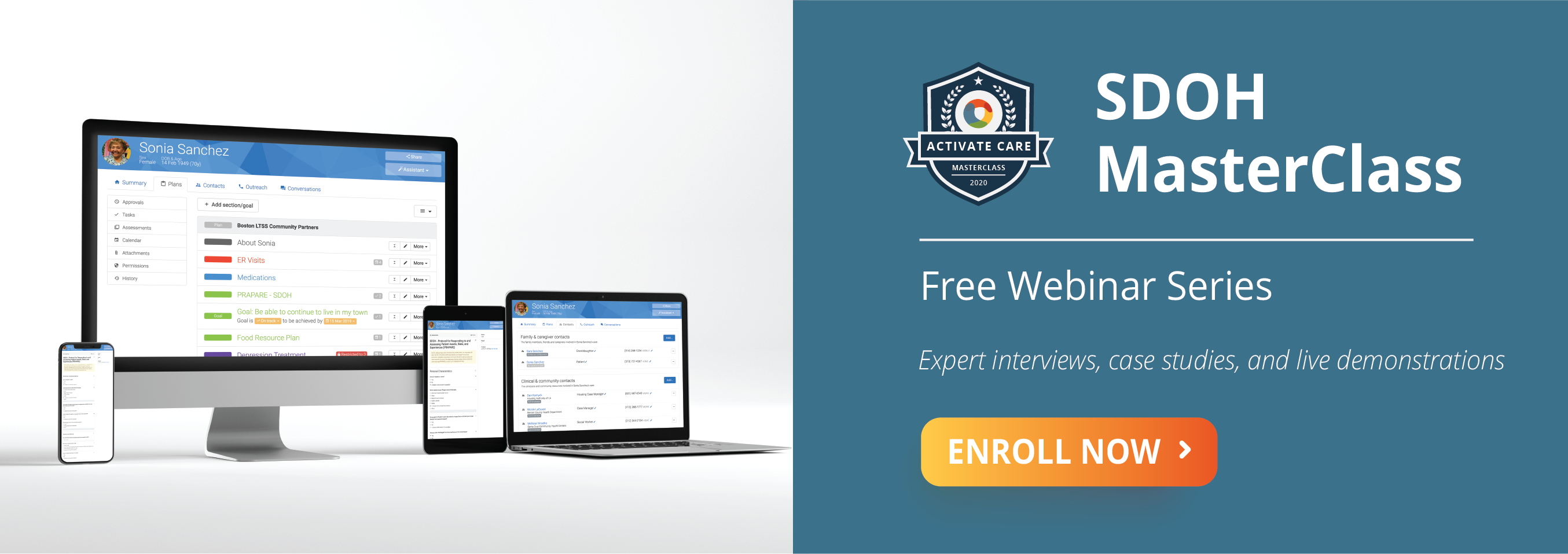We have been grateful for the positive response to our free COVID-19 Response Platform. Communities across the country have been getting up and running very quickly with help from our dedicated Implementations Team. Based on the operational and resource challenges we have seen healthcare and social services teams dealing with lately, we can empathize with the many changes in organizational culture, team productivity, and overall morale in healthcare and social services today.
Despite these challenges, many community leaders we talk to are trying to do whatever they can to keep their SDOH and community health initiatives moving forward. Social distancing and remote working don’t make these efforts easy. Without the ability to meet one-on-one or in small groups, it has become especially trying to think of ways to engage the community and keep your community's needs at the center of your work. Our team of experts offers some solutions to help.
1. Take advantage of free and easy digital tools to bring your organization online.
Outreach is critical during COVID-19. With drop-in programs and in-person events suspended, many communities are mobilizing their street teams to ensure community outreach continues. It’s also important to consider how digital tools can help you keep up with outreach and engagement. These tools might also help you expand your capacity.
Miyong Kim, the associate vice president for community health engagement at UT Austin, told UT News on April 6 that they are “completely revamping” their African American Church-Based Mental Health and Wellness (AMEN) program to go online, which will “reach beyond current participants to assist more community members affected by the crisis” and “enable our program to deliver more tools to partnering churches.”
In the midst of the current crisis, we are inspired by the efforts of countless care providers and caregivers like the AMEN Team at UT Austin. We know that resources will continue to be strained in the weeks and months ahead. With this in mind, Activate Care is pleased to offer a free COVID-19 Response Platform. This is our technology solution to help community programs, public health teams, and local agencies to track potential COVID-19 cases, monitor those that are already in the system, and get every stakeholder in the community on the same page for an effective response to this long-term crisis.
 Matt Goudreau is Activate Care’s Senior Director of Implementations. As a 30-year veteran of paramedicine and emergency response, Matt took the lead on designing our COVID-19 Response Platform. If you want to work with Matt to get your community’s case management and contract tracing effort out of spreadsheets and into a secure database, just raise your hand here and we can get you up and running in a few hours.
Matt Goudreau is Activate Care’s Senior Director of Implementations. As a 30-year veteran of paramedicine and emergency response, Matt took the lead on designing our COVID-19 Response Platform. If you want to work with Matt to get your community’s case management and contract tracing effort out of spreadsheets and into a secure database, just raise your hand here and we can get you up and running in a few hours.
2. Sharpen your health equity lens in order to keep your clients’ needs front and center.
Community leaders need to undertake a critical task right now: make sure that your community outreach is oriented to practical steps that consumers can take right now. What people need now are easy next steps and tangible support. Often when I look at information about a particular social resource, I see irrelevant, outdated, and frankly unhelpful information; what is glaringly lacking is any direction on what I need to do as a consumer of a service. COVID-19 is compounding the challenge. For example, some food pantries - a lifeline for many in our communities - are offering delivery-only service to encourage social distancing.
In the All In - Data for Community Health online forum, community members have been discussing ways to keep local engagement alive and well. All In member Peter Eckart of the Illinois Public Health Institute generously shared that he was recently talking with leaders in New York City who “have shifted a lot of their services to telehealth, and [he] asked them how they are able to maintain the ‘community feel’ of their services. They said that the answer is food. Food security is an especially big issue in their community right now, and they are able to connect their virtual services, like telehealth, to partners in the community who are providing physical services like food. Now, as ever, we have to meet people where they are.”
Our disconnected healthcare and social services systems disproportionately impact people experiencing social needs, especially in times of personal and societal crisis. These needs are often exacerbated or directly caused by systemic issues of equity and discrimination. We know that we have the tools and skills to change systems; Activate Care offers telehealth and community coordination tools as part of our free COVID-19 Response Platform. We are honored that so many communities are inviting us in as a partner during this time.
 Rich Porcelli is Activate Care’s Director of Community Engagement. As a practicing behavioral health therapist and a Health Leads alum, Rich works with Activate Care communities across the country to activate, launch, and scale integrated networks of healthcare and social services organizations.
Rich Porcelli is Activate Care’s Director of Community Engagement. As a practicing behavioral health therapist and a Health Leads alum, Rich works with Activate Care communities across the country to activate, launch, and scale integrated networks of healthcare and social services organizations.
3. Leverage data from across your community to show how care can improve.
One of the most rewarding aspects of working at Activate Care is that we get to see the real impact of our technology and services in communities across the country. We are committed to supporting communities doing this important work with our Activate CareHub™ platform, which encompasses SDOH care coordination tools, community referral management across social services, as well as my domain of expertise - analytics and reporting.
The data surrounding COVID varies from state to state, and county to county. In Colorado, for example, the Denver Post explains that there appears to be a declining number of new cases, but deaths continue to rise. While the numbers may change, the truths behind the numbers do not. In a blog post earlier this month, Joe Sammen, executive director at Colorado’s Center for Health Progress, explained why: “While many of us are still trying to navigate and make sense of new realities, it’s clear this pandemic will have greater consequences for some communities more than others. Those with the least access to economic, social, and political resources and power are most likely to contract the disease and are also most likely to lose their income or health care during shutdowns and social distancing measures.”
By going beyond the numbers, our analytics and reporting capabilities help community-based health and social care leaders continuously improve the effectiveness and impact of their operating models. An Activate Care community in California works with a number of stakeholders to improve care and services for their homeless population. Their process necessarily includes data-sharing and quality assurance between organizations - a time-intensive and duplicative process. We're working to help them fix this. Analytical capabilities have the power to help change outcomes for people living with complex health and social needs.
 Caterina Hill is Activate Care’s Analytics Consultant. As a public health epidemiologist and lecturer at Harvard Medical School, Caterina shares her rich perspective with communities working to demonstrate, evaluate, and improve outcomes in community health and social well-being.
Caterina Hill is Activate Care’s Analytics Consultant. As a public health epidemiologist and lecturer at Harvard Medical School, Caterina shares her rich perspective with communities working to demonstrate, evaluate, and improve outcomes in community health and social well-being.
